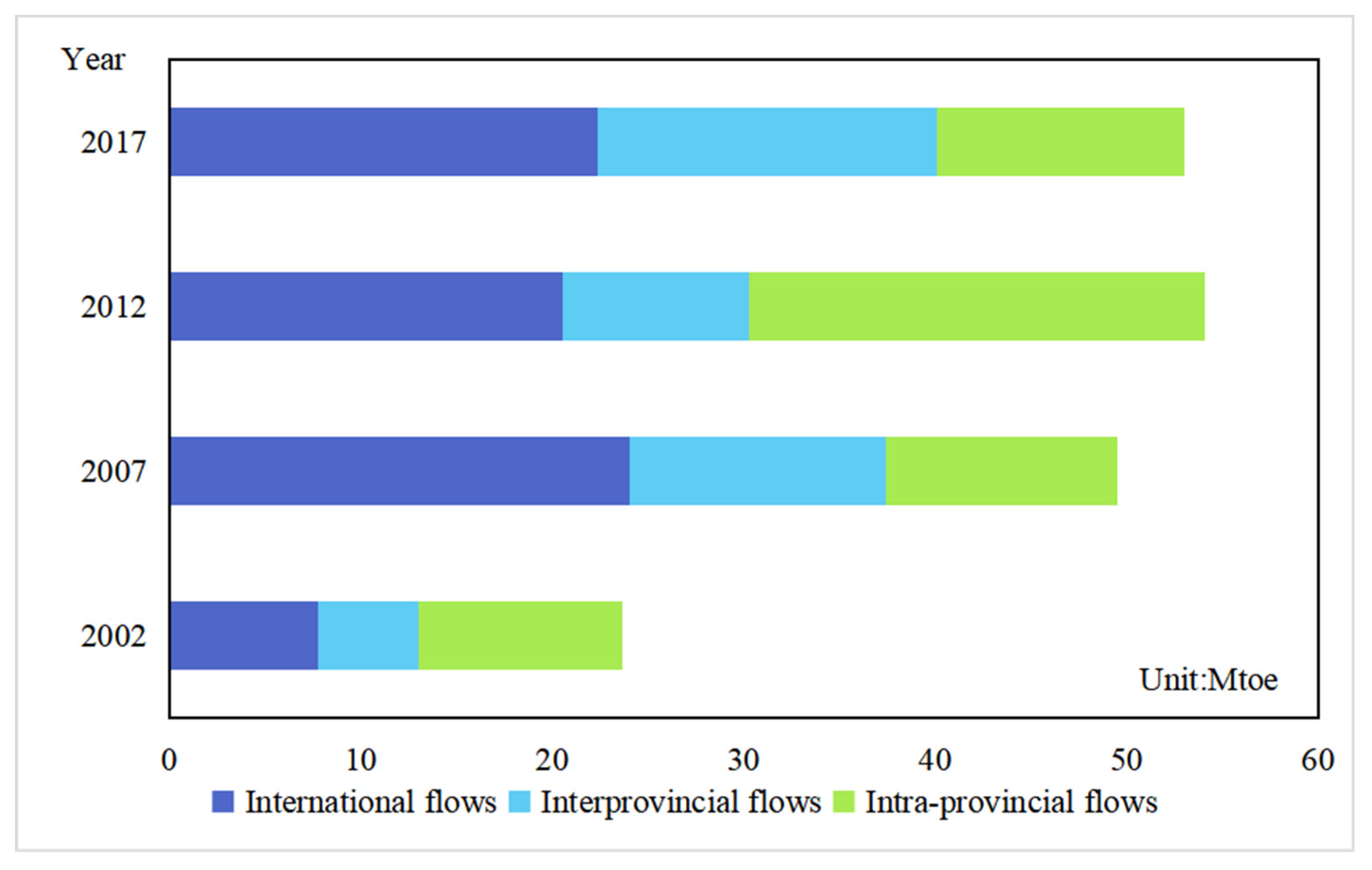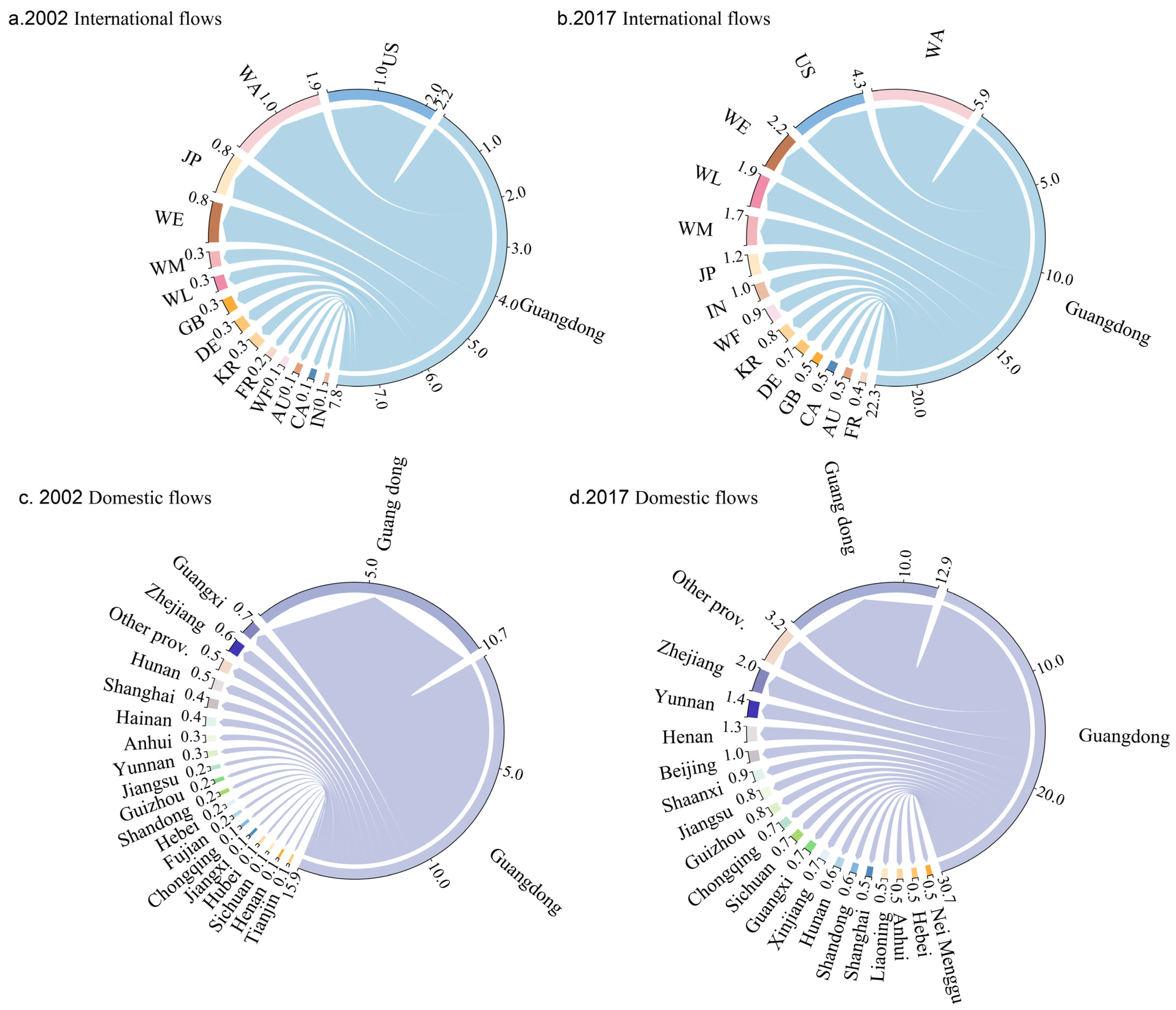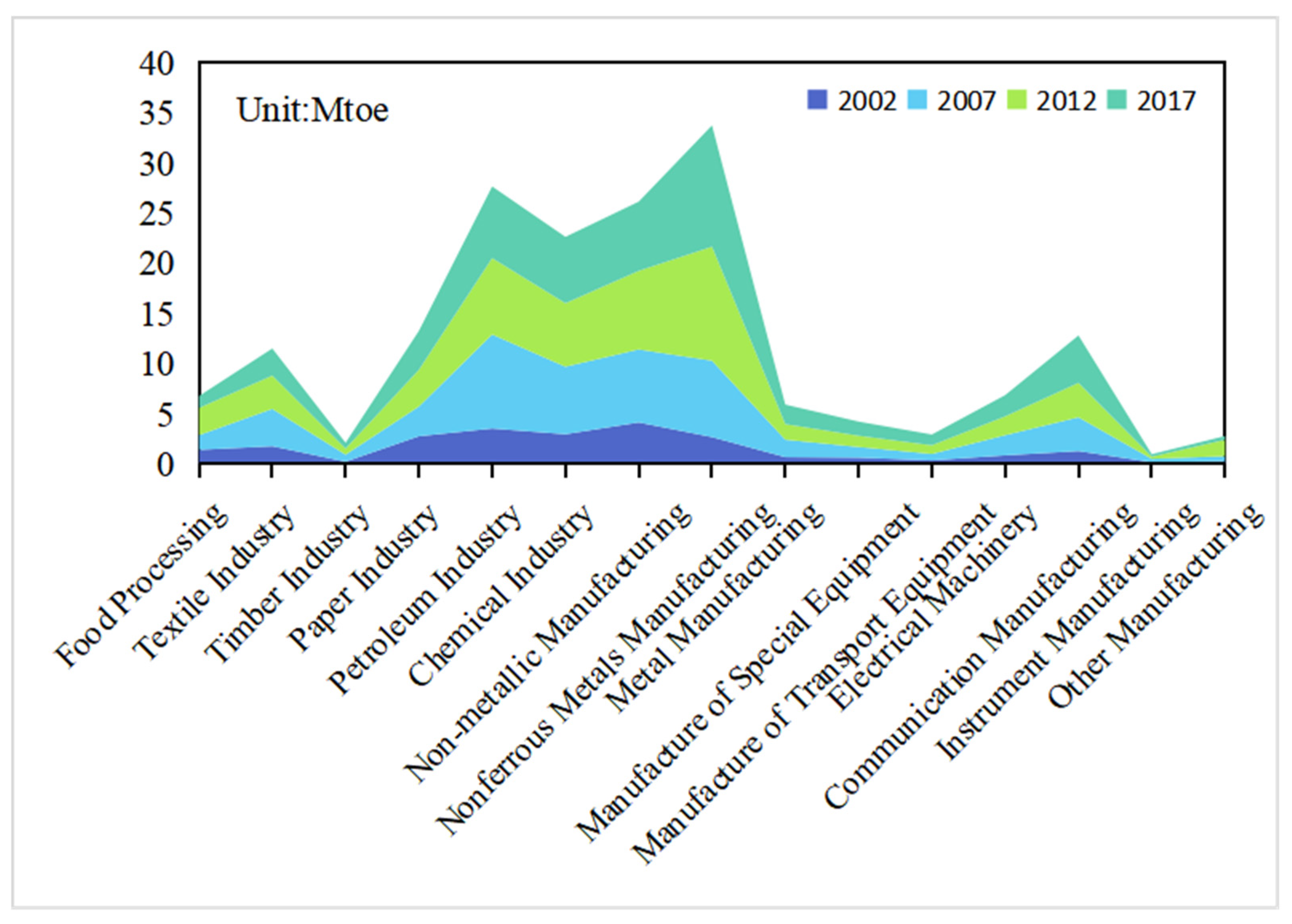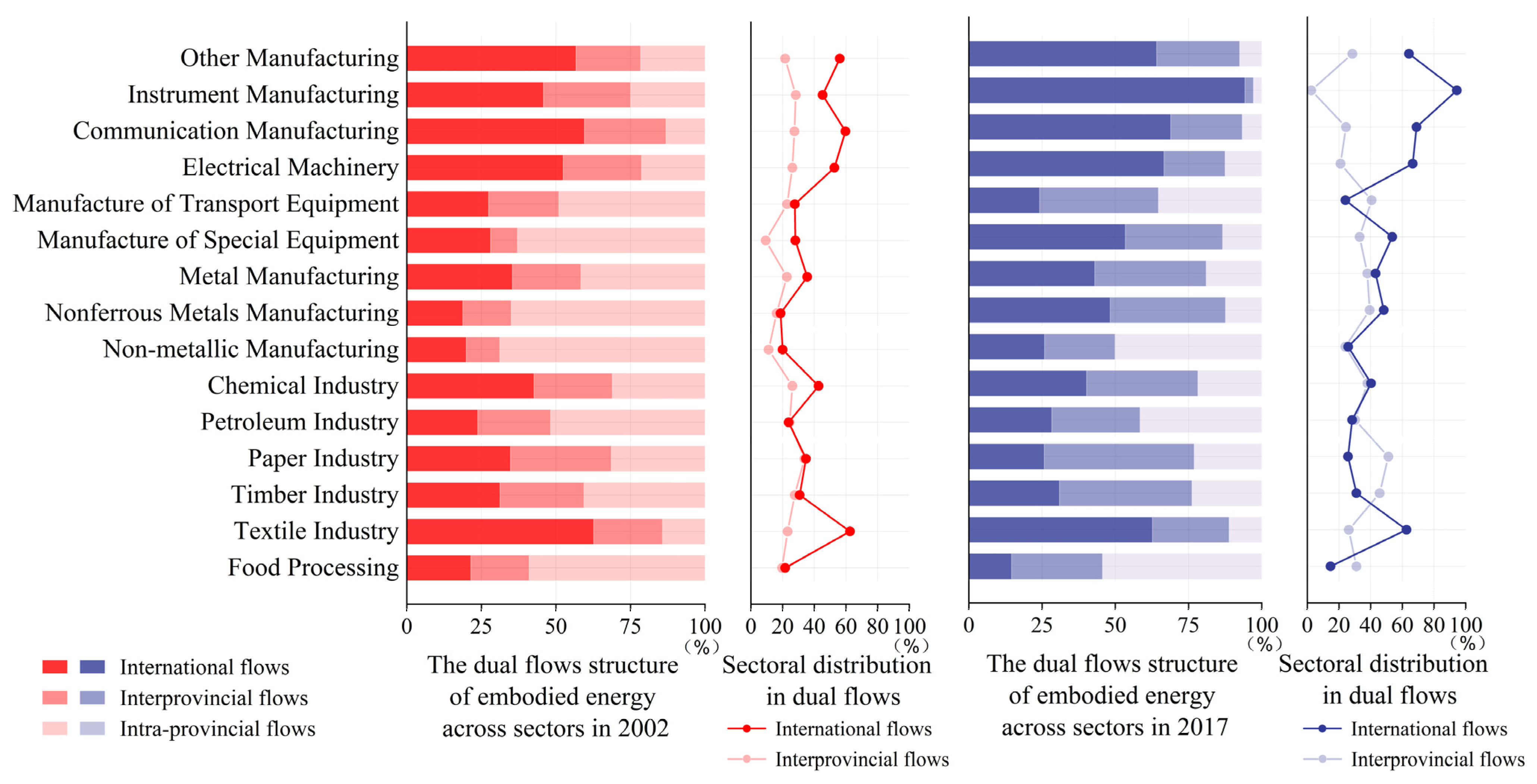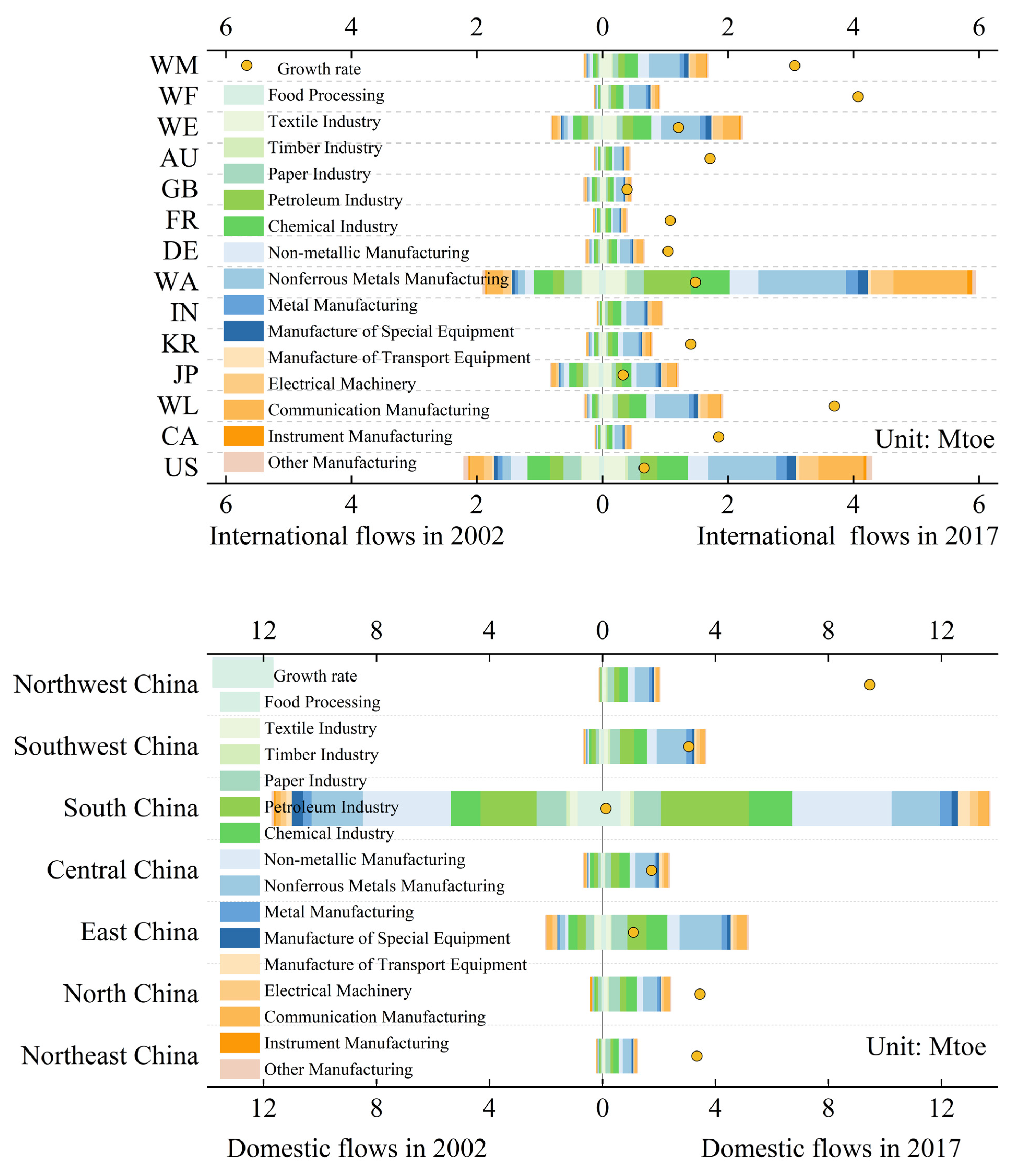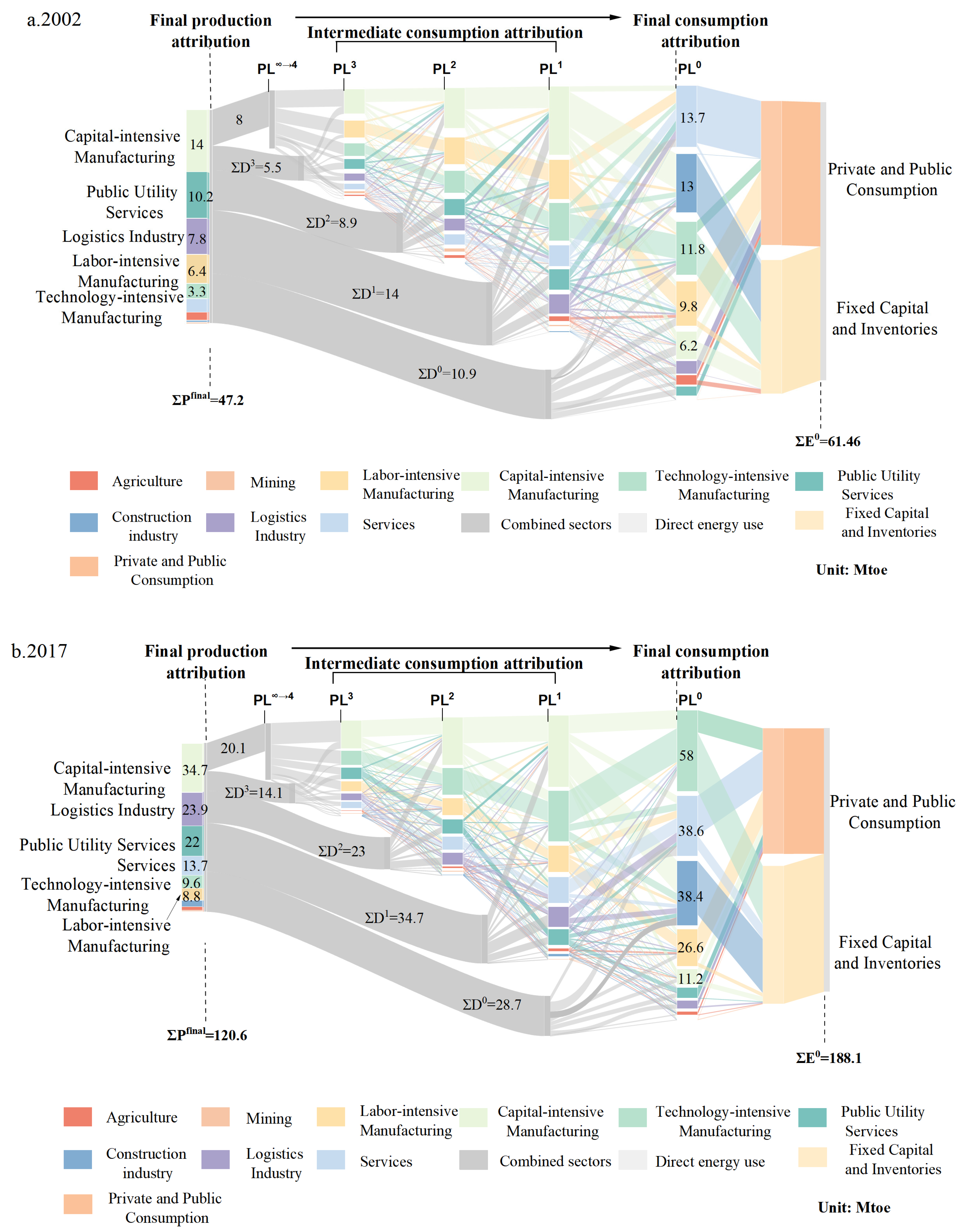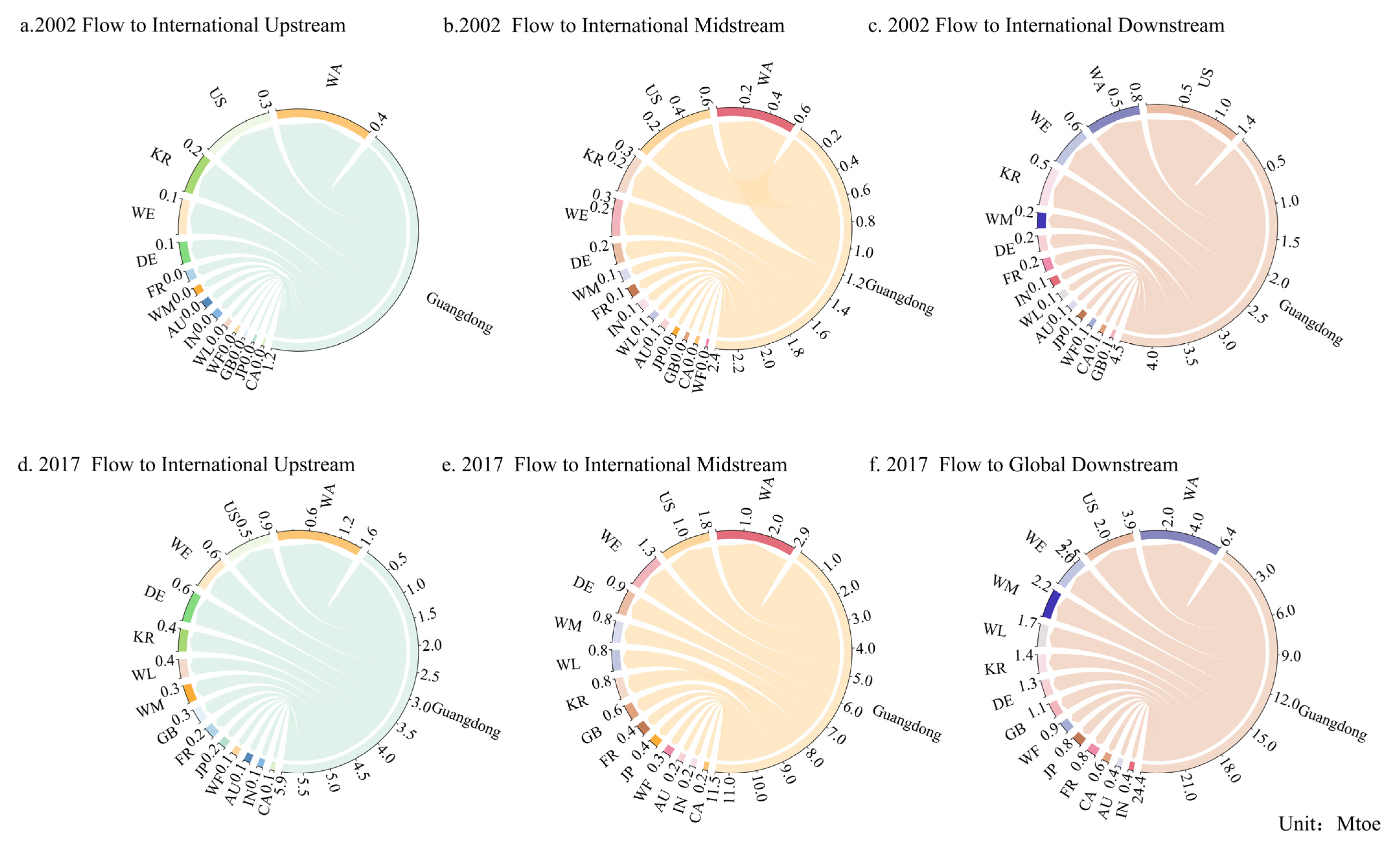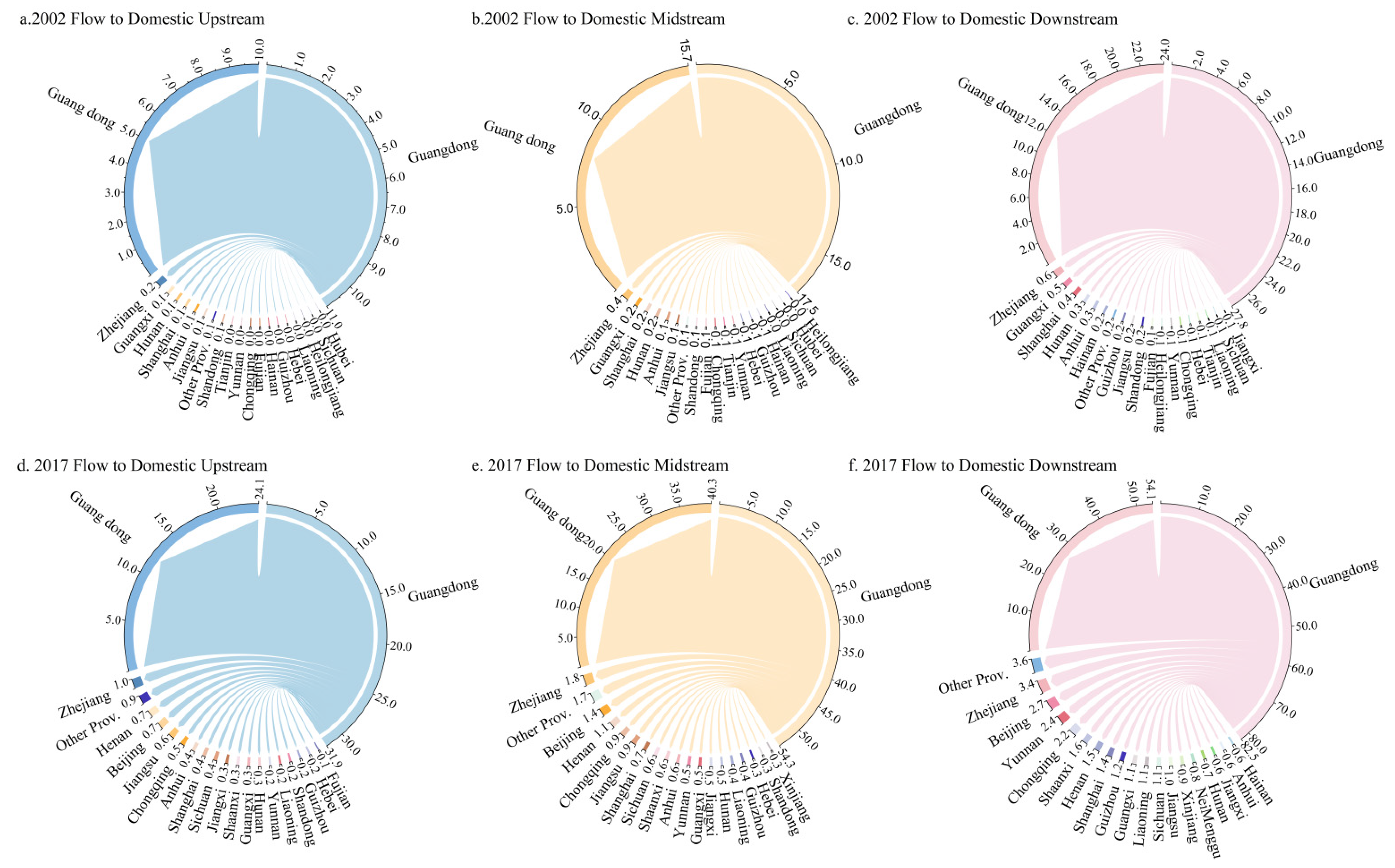1. Introduction
Over the past four decades, the global energy consumption pattern has undergone profound transformations, with total consumption more than doubling between 1980 and 2020 [
1]. As a key participant, China’s energy consumption has continued to expand, accounting for over one-quarter of the global total [
2]. In-depth studies show that China’s unique status as the “world’s factory” gives its energy use a dual nature—serving both domestic socioeconomic development and global market demand through international trade. A substantial share of China’s energy consumption is embodied in exports [
3,
4,
5], and its trade partners have gradually shifted from developed to emerging economies [
6,
7]. This “produced in China, consumed globally” pattern has established China as a pivotal hub in the global energy network [
8,
9,
10]. However, the significant regional heterogeneity within China adds complexity to this phenomenon: differences in resource endowments, industrial structures, and trade participation among provinces result in differentiated functional roles within both global and domestic energy flow networks [
11,
12]. This regional heterogeneity implies that analyses confined to the national level cannot fully capture the true dynamics of China’s energy system, nor can they provide the necessary policy leverage for provinces to formulate tailored, regionally specific policies to achieve national energy and SDG 12 goals.
As the country’s most economically developed province and a key trade gateway, Guangdong is deeply embedded in these multi-layered energy dynamics and plays a crucial supporting role in China’s overall energy security framework [
13,
14]. Therefore, this study takes Guangdong as a case to examine embodied energy flows at the interprovincial scale, quantifying its energy transfer patterns in both global and domestic trade and exploring its strategic role in ensuring national energy security—thereby improving our understanding of embodied energy flows in the process of China’s globalization.
The concept of embodied energy (EE), originating from systems ecology, refers to the total direct and indirect energy consumed throughout the life cycle of a product or service, including production, processing, and transportation [
1]. Most existing studies employ multi-regional input–output (MRIO) analysis to investigate the spatiotemporal characteristics of embodied energy flows between countries. Empirical results reveal that the global energy system exhibits strong interconnectedness and small-world network properties [
15]. As the field has evolved, traditional economic theories—such as unequal exchange—have been extended to explain environmental inequalities embedded in international trade, particularly the transfer of environmental burdens from developed to developing countries [
16,
17,
18]. In the early 21st century, global embodied energy trade grew rapidly at an average annual rate of 5%, accounting for 34% of total energy use. During this period, China became the world’s largest embodied energy exporter, while the United States emerged as the largest net importer—highlighting the complexity and asymmetry of the global energy flow system [
19,
20,
21,
22,
23].
Beyond extensive cross-national studies, some scholars have also examined intra-national regional disparities [
24,
25]. Empirical studies based on environmentally extended input–output data demonstrate that significant environmental inequality effects also exist within interprovincial trade [
26,
27]. Although the theory of comparative advantage suggests that embodied energy trade can alleviate regional energy shortages and promote economic development [
28], recent studies have found that China’s industrial relocation has exacerbated spatial imbalances in embodied energy flows, leading to socioeconomic disequilibrium and environmental justice issues at the regional scale [
29,
30]. Some scholars argue that eastern coastal provinces retain most of the economic value added while transferring consumption-related embodied energy burdens to inland regions—creating a dual dilemma of high energy consumption and low value-added retention in less developed areas, with this inequality showing an expanding trend [
31]. Nevertheless, other studies highlight that well-designed interregional compensation mechanisms can help transform such trade-induced disparities into drivers of coordinated regional development [
23].
Despite these contributions, existing research still faces two critical theoretical limitations. First, while national-level analyses reveal the highly interconnected nature of global energy networks, they tend to treat countries as homogeneous units, overlooking the substantial heterogeneity among provinces in terms of resource endowments, industrial structures, and development stages [
30,
32,
33]. Second, most interprovincial studies analyze domestic and international trade separately, failing to recognize the province as an open economic system that bridges global and domestic circulations. This limitation is particularly evident when analyzing China’s regional development, as the rapid growth of eastern coastal provinces is closely tied to their deep integration into global value chains [
34]. Consequently, current research struggles to fully capture the multi-layered and dynamic roles of Chinese provinces within global–domestic circulation systems. This gap constrains the effectiveness of regional energy policies and poses challenges for assessing the resilience of the national energy system.
To overcome these limitations, this study innovatively integrates the Exiobase global input–output database with China’s multi-regional input–output tables released by the National Bureau of Statistics, constructing a nested, province-extended global input–output database. By applying an energy-account extension method, a nested energy-extended multi-regional input–output (EEMRIO) model is developed to characterize the transfer patterns and dynamic evolution of embodied energy in Guangdong’s manufacturing sector across both global and domestic circulation systems. Furthermore, the structural path analysis (SPA) method is employed to identify the key transmission paths and critical industrial nodes within the dual-circulation framework. The findings not only elucidate Guangdong’s strategic role in safeguarding national energy security but also enhance the understanding of provincial embodied energy flows and their spatial transmission mechanisms—providing empirical evidence and policy insights for strengthening the resilience of China’s energy system and optimizing its spatial energy configuration.
2. Data and Methodology
2.1. Nested Multi-Regional Input–Output Analysis
Input–output analysis, since its inception by Leontief in the 1930s, has become a fundamental methodological tool for examining economic interdependencies. Among its extensions, the environmentally extended input–output (EEIO) model has attracted considerable attention for its ability to trace resource flows and environmental footprints embedded in international trade. Nevertheless, existing approaches exhibit notable limitations in spatial resolution: global analyses typically treat countries as homogeneous units, whereas China’s multi-regional input–output (MRIO) tables, while capturing inter-provincial economic linkages, lack detailed information on the directionality of international trade. To overcome these dual limitations and improve the accuracy of empirical results, this study nests China’s provincial MRIO tables within the Exiobase global input–output database, constructing a province-extended global MRIO model that links 48 global economies with 30 Chinese provinces in a unified framework of 78 regions × 21 sectors.
To ensure temporal consistency and comparability across economies, the raw datasets were preprocessed prior to model construction. The 163 Exiobase sectors and the original number of China MRIO sectors (up to 42) were aggregated into 21 common sectors. This was necessitated by a critical data constraint: the 2002 China MRIO table, serving as our temporal baseline, only contains 21 sectors. Therefore, to maintain structural continuity and ensure strict comparability across all four study years (2002, 2007, 2012, and 2017), we adopted this 21-sector classification as the minimal necessary aggregation scheme. Using annual average exchange rates, Chinese MRIO data (in 10,000 RMB) and Exiobase data (in million euros) were converted into current-year million USD. The nested model relies on the decomposition and reconstruction of China-related submatrices within the intermediate consumption matrix (Z) and final demand matrix (Y). A proportional allocation method was first applied, using provincial-level trade statistics to distribute Exiobase’s aggregated country-level trade flows according to each province–sector’s share in national international trade, achieving province-level disaggregation of international flows. Subsequently, a double-proportional balancing procedure (RAS method) was iteratively applied to enforce input–output balance constraints and maintain consistency with Exiobase’s country totals. This two-step procedure ensures coherent integration of domestic inter-provincial trade and international trade within a single framework, preserving coordination and consistency across spatial scales [
35]. The province-level decomposition of international transactions is formally expressed as follows:
Here, represents the output or services from sector i of Chinese province j exported to country/region A in the nested framework; denotes the corresponding exports derived from provincial international trade statistics; indicates the total international exports of sector i from province j based on trade statistics; and stands for the balanced total final exports of sector i from province j after adjustment. For trade data processing at the provincial-sector level, import allocation follows a symmetric approach to export treatment. Regarding the initial input matrix, balancing adjustments ensure consistency between provincial data in China’s MRIO table and national totals in the Exiobase table.
2.2. Environmentally Extended Input–Output Model
This study employs an environmentally extended input–output (EEIO) model to examine Guangdong Province’s embodied energy consumption patterns and structural characteristics in international and domestic trade, with a focus on tracking cross-regional flows of products through international supply chains [
36]. Based on the fundamental balance relationship in input–output modeling, the total regional output can be expressed as a function of final demand:
Here, I is the identity matrix, A denotes the direct input coefficient matrix, and L represents the Leontief inverse matrix. In the final demand matrix Y,
indicates the national final demand in region r,
(interprovincial flows) represents the final demand exported from province r to s, and Y
rt (international flows) denotes the final demand exported from province r to country t. The direct input coefficient matrix A can be further expressed as the following block matrix:
Here, element denotes the direct product input from sector i in region r consumed per unit output of sector j in region s, where r, s, and t represent the 78 regions, and i and j indicate the 21 industrial sectors.
Based on the traditional input–output model, we further introduce energy consumption F from the resource-environment account and energy intensity coefficients, yielding (Equation (4)), where E represents final demand-based embodied energy consumption, also called embodied energy consumption. The data flow of the environmentally extended nested input–output is shown in
Figure 1.
2.3. Industrial Concentration Measurement
The Herfindahl–Hirschman Index (HHI) [
37] is a measure of market concentration, calculated as:
This study extends its application to measure the market concentration of embodied carbon exports, where Xi represents the embodied energy exported to the i region and X denotes the total embodied energy. A decreasing HHI indicates that embodied energy flows are dispersing from a few core regions to more regions, reflecting enhanced distribution diversity.
The coefficient of variation (CV) is a relative measure of data dispersion [
38], calculated as:
where
represents the standard deviation and
denotes the mean value. In the analysis of regional embodied energy distribution, a lower coefficient of variation indicates more balanced energy allocation across regions, while a higher value reflects greater concentration.
2.4. Structural Path Analysis (SPA)
The Structural Path Analysis (SPA) method systematically tracks the flow of resources and environmental factors throughout supply chains, from upstream material inputs to downstream final demand, identifying critical pathways of embodied elements [
39,
40,
41]. This study applies SPA to quantify direct and indirect energy consumption across industrial sectors at different tiers within Guangdong’s dual-flow (international/domestic) supply chains, revealing transfer directions and volumes of embodied energy between sectors to identify key influential sectors. Specific calculation formulas follow [
40]. For analytical clarity, the 21 industrial sectors are consolidated into 9 broader categories.
According to SPA methodology, the Leontief inverse matrix L can be expanded via Taylor series into different tiers as shown in Equation (7):
Here, L denotes the Leontief inverse matrix, where each element Lpq represents the total (direct and indirect) amount of output from sector p required to produce one unit of output in sector q. Assume there are N sectors in total. A is the direct technical coefficient matrix, with each element apq indicating the direct input from sector p needed to produce one unit of output in sector q.
The m matrix can be derived from Equation (8), where each element mq quantifies the total (direct and indirect) energy consumption per unit output of sector q.
The direct energy consumption (
) of different sectors at each tier can be calculated using the following formula (
Table 1), where y denotes the final demand matrix, indices i, j, k, l represent distinct sectors, and 0, 1, 2, 3 indicate successive tiers from downstream to upstream in the supply chain.
The calculation formula for embodied energy flows (
) between sectors across supply chain tiers is presented in
Table 2.
2.5. Data
This study constructs a cross-regional, multi-sector nested input–output model based on the Exiobase global multi-regional input–output database and the Multi-Regional Input–Output (MRIO) data published by the National Bureau of Statistics of China (NBS), covering the years 2002, 2007, 2012, and 2017. The selection of this time span is primarily constrained by the fact that the latest publicly available official Chinese MRIO tables extend only to 2017. The Exiobase database provides trade flows and energy consumption satellite accounts for 49 global economies (including 27 EU member states, 17 non-EU economies, and 5 other regions), while China’s MRIO data captures economic linkages across 30 provincial-level administrative regions. To ensure temporal comparability, all economic data were harmonized using exchange rates and expressed in current-year U.S. dollars (USD). For accurate provincial-level disaggregation of international trade flows, provincial industry trade data from the China Customs Database were used as auxiliary information.
Through sectoral aggregation, the raw data were consolidated into 21 sectors (as detailed in
Section 2.1), with a focus on 15 manufacturing sectors. These manufacturing sectors were further classified based on factor endowments into labor-intensive, capital-intensive, and technology-intensive manufacturing (see
Supplementary Materials for details). Regarding environmental accounting, all energy data were uniformly converted according to the “General Principles for Calculation of the Comprehensive Energy Consumption” (GB/T2589-2020) [
42], adopting million tonnes of oil equivalent (Mtoe) as the final metric. During this process, provincial energy consumption structural ratios from the CEADS database were used to allocate national total energy consumption to the provincial-sectoral level, thereby constructing an accurate direct energy intensity vector (f) and ensuring a high degree of consistency between energy and economic flows through the entropy balancing method [
42,
43].
3. Results
3.1. Evolution of International and Domestic Flow Structures
During the period 2002–2017, Guangdong’s manufacturing sector underwent significant structural transformations in embodied energy flows, exhibiting a phased characteristic of “increasing international flow–resurgence of intra-provincial flow–expansion of interprovincial transfer” (
Figure 2). The 2002–2007 period marked the growth phase of international embodied energy transfer. Following China’s WTO accession, the total embodied energy in Guangdong’s manufacturing sector demonstrated remarkable growth, increasing from 23.7 Million Tonnes of Oil Equivalent (Mtoe) to 49.6 Mtoe, with an average annual growth rate of 15.9%. This period was characterized by the strengthening of international transfers, with its share of embodied energy rising from 33% to 48.6%, achieving an impressive annual growth rate of 25%. Notably, the embodied energy intensity of exports (0.24 Mtoe/Bn USD) was significantly lower than both intra-provincial (0.53 Mtoe/Bn USD) and domestic (0.52 Mtoe/Bn USD) levels, indicating that manufacturing sectors engaged in international competition exhibited higher energy efficiency. This phenomenon may be attributed to the competitive pressures of international markets driving enterprises to adopt more advanced production technologies and energy management practices.
The 2007–2012 period represented the resurgence phase of intra-provincial embodied energy flows. Impacted by the international financial crisis, the growth rate of Guangdong’s manufacturing embodied energy decelerated substantially to an annual average of 1.6%, reaching 53.9 Mtoe by 2012. In this period, the share of international transfers declined to 38%, while domestic transfers rebounded to 62%, with intra-provincial flow increasing significantly from 24.5% to 44%. Concurrently, the embodied energy intensity of both international exports and local consumption improved to 0.14 Mtoe/Bn USD and 0.32 Mtoe/Bn USD, respectively, outperforming the 0.48 Mtoe/Bn USD for domestic exports. This suggests that regional manufacturing maintained international competitiveness through energy efficiency improvements, while potentially diffusing high-efficiency production models from export-oriented sectors to local industries.
The 2012–2017 period witnessed the expansion phase of interprovincial embodied energy transfer. The total embodied energy experienced a marginal decline to 53.1 Mtoe, representing an annual decrease of 0.3%. Domestic flows maintained their dominant position at 58%, with interprovincial transfers rising to 33%, establishing a dual-flow development pattern that balanced domestic and international flows. The most notable advancement during this period was the comprehensive improvement in energy efficiency, with embodied energy intensities for international, interprovincial, and intra-provincial flow optimizing to 0.1, 0.17, and 0.23 Mtoe/Bn USD, respectively, demonstrating a significant narrowing of the efficiency gap between domestic and international flows. Particularly noteworthy was the fact that interprovincial flow achieved higher energy efficiency than intra-provincial flow for the first time, primarily attributable to its remarkable 36% annual growth in value-added against a mere 12% growth in embodied energy. This reflects substantial energy efficiency improvements in Guangdong’s manufacturing sector, as it served the domestic economic flow.
3.2. International and Domestic Flow Patterns
Between 2002 and 2017, Guangdong’s manufacturing sector exhibited a pronounced diversification trend in the spatial distribution of embodied energy transfers, both internationally and domestically. The structure of export markets shifted markedly from advanced economies to emerging economies (
Figure 3a,b), with the combined share of the US, Japan, Germany, South Korea and the UK declining from 49.28% to 33.26%. The US share fell 9 percentage points to 19%, while Japan’s halved to 5.4%, accompanied by significant efficiency gains—US export intensity dropped from 0.14 to 0.09 Mtoe/Bn USD, indicating product optimization. Concurrently, the embodied energy intensity of exports to developing economies (India, Indonesia, Brazil, Mexico and Turkey) improved substantially from 3.7% to 9.5%, with India growing 17% annually to reach 4.3% (0.98 Mtoe). Latin America (“other Latin American countries”) increased from 2.4% (0.21 Mtoe) to 6% (1.4 Mtoe), while the Middle East (“other Middle Eastern countries”) grew from 4% (0.35 Mtoe) to 7.5% (1.7 Mtoe).
This geographical restructuring reflects a highly complementary relationship between Guangdong’s export supply and the demand dynamics of rapidly industrializing emerging markets. For example, in 2017, India’s primary imports from China—electromechanical goods (40.35 billion) and chemical products (10.45 billion)—closely aligned with Guangdong’s core export strengths. This synergy, coupled with rising industrial demand in emerging economies, drove export expansion while simultaneously enhancing energy efficiency. Notably, the embodied energy intensity of Guangdong’s exports to India fell by 31.2% (from 0.16 to 0.11 Mtce per billion EUR). This transition exemplifies a dynamic industrial realignment mechanism: by relocating energy-intensive production phases to regions with comparative cost advantages, Guangdong achieved growth in embodied energy exports while reducing direct local energy consumption—a clear manifestation of “metabolic decoupling” (
Figure 3a,b). Such a shift underscores Guangdong’s ascendancy within global value chains, leveraging both efficiency gains and strategic market diversification.
From 2002 to 2017, the interprovincial transfer of embodied energy in Guangdong’s manufacturing sector exhibited a distinct spatial redistribution, characterized by a shift from economically advanced eastern regions toward less-developed western regions (
Figure 3c,d). The eastern regions, traditionally dominant in Guangdong’s embodied energy trade, experienced a notable decline in their share, with East China maintaining the highest proportion despite decreasing from 38.78% (2 Mtoe) to 29.07% (5.2 Mtoe), while South China’s share dropped from 20.19% (1.1 Mtoe) to 4.71% (0.8 Mtoe). This transition was accompanied by reduced embodied energy intensity (both declining from 0.18 and 0.33 to 0.16 Mtoe/Bn USD, respectively), indicating substantial industrial upgrading and energy efficiency improvements in coastal regions. Shanghai and Hainan exemplified this trend: Shanghai’s share decreased from 8.2% (0.42 Mtoe) to 3% (0.56 Mtoe) while its intensity increased from 0.13 to 0.2 Mtoe/Bn USD, reflecting structural changes from strategic emerging industries (16.4% of output value in 2017) like integrated circuits and bio-medicine; whereas Hainan’s share declined from 7.6% (0.42 Mtoe) to 1% (0.21 Mtoe) with intensity dropping sharply from 0.45 to 0.13 Mtoe/Bn USD, demonstrating successful decoupling through tourism-led development (56% tertiary sector share).
Concurrently, western China assumed an increasingly prominent role in Guangdong’s embodied energy trade. The southwest region’s share increased from 13.2% (0.7 Mtoe) to 20.7% (3.6 Mtoe), while the northwest region grew from 2.7% (0.14 Mtoe) to 11.6% (2 Mtoe), representing increases of 56.8% and 324.4%, respectively. Although both regions showed improved energy intensity (declining from 0.25 and 0.22 to 0.19 Mtoe/Bn USD in the southwest and northwest), these levels remained higher than eastern regions, indicating persistent demand from energy-intensive industries during western industrialization. At the provincial level, Yunnan in the southwest demonstrated the most notable growth, rising from 4.7% (0.28 Mtoe) to 8.1% (1.5 Mtoe), while Xinjiang in the northwest showed the most significant expansion, increasing from 0.6% (0.04 Mtoe) to 3.7% (0.7 Mtoe).
3.3. International vs. Domestic Manufacturing Embeddedness
From 2002 to 2017, Guangdong’s manufacturing underwent a structural shift in embodied energy concentration from traditional labor- and capital-intensive industries toward more capital- and technology-intensive sectors with increased specialization (
Figure 4). In 2002, the top five energy-intensive sectors, non-metallic manufacturing (4.2 Mtoe), petroleum industry (3.6 Mtoe), chemical industry (2.9 Mtoe), paper industry (2.7 Mtoe), and nonferrous metals manufacturing (2.7 Mtoe), accounted for 68% of total embodied energy, reflecting Guangdong’s early industrialization stage dominated by energy/resource-intensive production. The prominence of non-metallic manufacturing and the petroleum industry specifically mirrored infrastructure demands (
Figure 3). By 2017, the composition shifted to nonferrous metals manufacturing (12.1 Mtoe), petroleum industry (7.1 Mtoe), non-metallic manufacturing (6.9 Mtoe), chemical industry (6.7 Mtoe), and communication manufacturing (4.8 Mtoe), with aggregate share rising to 71%.
Among all sectors, non-ferrous metal manufacturing exhibited the most rapid growth in embodied energy consumption within Guangdong’s manufacturing industry, with an annual average growth rate of 10.6%, driven principally by strategic emerging industries like new energy vehicles (NEVs). Data from DuckerFrontier reveals pure electric vehicles require 292 kg of aluminum per unit, 42% higher than conventional vehicles, with particularly strong demand growth for automotive aluminum sheets. This trend aligned closely with Guangdong’s industrial policy, which designated NEVs as a priority sector in 2012, achieving production of 30,000 units and a capacity of 150,000 units by 2017. Concurrently, the manufacture of transport equipment maintained steady 7.6% growth, reflecting coordinated industrial upgrading. Notably, while all manufacturing sectors expanded embodied energy use, efficiency improved significantly; the timber industry and paper industry reduced energy intensity by 293% and 177%, respectively, through technological upgrades, consistent with Guangdong’s innovation-driven development strategy and green manufacturing policies.
From the perspective of domestic and international transfer patterns, the embodied energy flows of technology-intensive manufacturing exhibited a distinct international transfer bias between 2002 and 2017, accompanied by a widespread increase in foreign dependency (
Figure 5). In 2002, only 4 of Guangdong’s 15 manufacturing sectors were globally oriented: the textile industry (62.6% international share), communication manufacturing (59.7%), other manufacturing (56.1%), and electrical machinery (52.7%). Among these, only communication, manufacturing and electrical machinery were technology-intensive, reflecting Guangdong’s early-stage manufacturing base dominated by labor-intensive, nationally focused industries. During this period, only sectors with traditional export advantages (labor-intensive) or emerging technological capabilities could deeply integrate into global value chains. By 2017, globally oriented sectors increased to six, adding instrument manufacturing (94.4% international share) and manufacture of special Equipment (53.6%), both technology-intensive. Consequently, all five technology-intensive sectors developed international flow dependence. Existing export-oriented sectors also showed increased external reliance, particularly communication manufacturing (rising to 68.9%) and electrical machinery (to 66.6%).
While embodied energy transfers from Guangdong’s manufacturing sector demonstrate diversified patterns in both international and domestic flows, the spatial dispersion of interprovincial redistribution within China is markedly more pronounced than that of international flow (
Figure 6). Analysis of the coefficient of variation (CV) and Herfindahl–Hirschman Index (HHI) revealed that among 14 sectors with declining concentration, domestic flows averaged CV and HHI reductions of 43.4% and 46.9%, respectively, substantially exceeding the 17.8% and 19.3% decreases for international flows.
The most pronounced domestic diversification occurred in capital- and technology-intensive sectors. Nonferrous metals manufacturing (CV −71.8%, HHI −73.5%), manufacture of special equipment (CV −70.5%, HHI −74.9%), and communication manufacturing (CV −53.6%, HHI −41.8%) showed the steepest declines. For instance, the non-ferrous metal sector’s share in South China plummeted from 83.8% to 27.4%, while the Northwest and Southwest regions grew to 8.2% and 16.9%, respectively. Conversely, international flow decentralization was most prominent in labor- and capital-intensive sectors: timber industry (CV −30.8%, HHI −32%), manufacture of special equipment (CV −27.6%, HHI −28.6%), and textile industry (CV −26.7%, HHI −25.6%). Textile exports to traditional markets like the US (25% → 20%) and Japan (14% → 7%) declined, while emerging markets such as India (0.8% → 2.3%) and Brazil (0.3% → 1.3%) gained share.
3.4. Embodied Energy Inter-Industry Flows
By decomposing supply chains into four tiers (PL3: upstream, PL2: mid-upstream, PL1: mid-downstream, PL0: downstream), this study systematically reveals the transmission mechanisms of embodied energy through industrial chains (
Figure 7). The analysis quantifies both direct and embodied energy consumption across sectors at each tier while characterizing cross-sectoral flow patterns. Specifically, it traces complete embodied energy pathways from raw materials to final products, providing a systemic perspective on inter-industrial energy transmission. Empirical results show significant growth in embodied energy flows across all tiers during 2002–2017, with downstream flows increasing 3.4-fold (from 27.9 to 95.8 Mtoe), exceeding the 3.1-fold upstream growth (12.2 to 37.8 Mtoe). This divergence indicates a clear downstream shift in Guangdong’s manufacturing energy focus, reflecting both deepened industrial structure and expanding end-consumer demand.
Note: The leftmost section displays production-based renewable energy consumption across nine sectors, with colors distinguishing sectoral contributions. Central deep gray lines represent direct energy consumption aggregated at each tier (PL3–PL0). Colored lines between PLt + 1 and PLt tiers depict inter-sectoral embodied energy flows, with flows from PL4 to PL3 consolidated as light gray lines. Line widths correspond to flow magnitudes. The rightmost section shows energy consumption driven by two types of final demand.
From 2002 to 2017, capital-intensive industries maintained dominance across all supply chain tiers (
Table 3). In 2017, they accounted for 35.4% (5 Mtoe), 35.8% (8.3 Mtoe), and 34.5% (12 Mtoe) of direct energy consumption at upstream (PL3), mid-upstream (PL2), and mid-downstream (PL1) tiers, respectively, representing increases of 4.8%, 4.9%, and −1.8% since 2002. Their embodied energy transfers also ranked highest, reaching 36% (20.2 Mtoe), 35.9% (34.2 Mtoe), and 33.5% (51.2 Mtoe) across these tiers. Beyond capital-intensive sectors, energy consumption gradually shifted from labor- to technology-intensive industries. Technology-intensive manufacturing showed the fastest growth in downstream embodied energy transfers (10.3% annual rate), with two of the top three downstream transfers involving technology-intensive sectors: intra-sector flows (15.7%, 24.1 Mtoe) and capital-to-technology industry transfers (8.5%, 13 Mtoe).
Guangdong’s manufacturing embodied energy flows during 2002–2017 demonstrated a dual-pattern of domestic-oriented flows with accelerating international flows throughout the entire industrial chain domestic flows substantially exceeded international flows across all production tiers in 2017: upstream (domestic 31.9 Mtoe vs. international 5.9 Mtoe), midstream (54.3 Mtoe vs. 11.5 Mtoe), and downstream (82.5 Mtoe vs. 24.4 Mtoe), with domestic volumes exceeding international flows by factors of 5.4, 4.7, and 3.4, respectively. Notably, international flows grew at higher annual rates, 11.3% (upstream), 11.2% (midstream), and 10.5% (downstream), surpassing corresponding domestic growth rates of 7.3%, 3.3%, and 4.3%.
Between 2002 and 2017, Guangdong’s manufacturing embodied energy flows exhibited diversified patterns in both international and domestic flows across all production tiers (
Figure 8). International flows showed significant tier-specific variations: exports to developed economies generally declined, with the most pronounced decreases to the US (downstream: −14.4%, midstream: −9.3%, upstream: −7.2%) and Japan (upstream: −5.1%, midstream: −5.9%, downstream: −6.2%). Notably, South Korea demonstrated upward trends among developed nations, particularly in upstream flows (+3.2%). Conversely, developing economies saw consistent growth, led by India (3.3–3.6% growth across tiers), followed by Mexico (1.2–1.4%growth) and Brazil (0.7–1.2%growth). This pattern reveals a complex international redistribution characterized by differential declines in advanced economies and universal growth in emerging markets, reflecting dynamic trade linkage adjustments in Guangdong’s manufacturing sector.
Nationally, the shift is particularly pronounced in downstream industrial chain segments (
Figure 9). Eastern coastal regions show widespread declines, with East China decreasing by 15.3%, 17.4%, and 19.6% in upstream, midstream, and downstream, respectively, while South China saw reductions of 8.2%, 9.4%, and 12.6%, revealing an expanding gradient of downstream > midstream > upstream. Conversely, central and western regions demonstrate comprehensive growth. Southwest China exhibits the most significant downstream increase (12.3%), followed by midstream (7.1%) and upstream (5.3%), while Northwest China similarly displays a downstream (9.6%) > midstream (6.1%) > upstream (5.3%) growth gradient. North China maintains steady growth across all segments (8.4%, 9.6%, and 9.8%, respectively), whereas Northeast and Central China show more limited increases, all below 3.2%. This evolving regional pattern indicates accelerated westward transfer of embodied energy from Guangdong’s manufacturing, with Southwest China emerging as a primary destination, particularly downstream-oriented, reflecting profound adjustments in China’s regional industrial layout.
4. Conclusions and Limitations
Based on a newly constructed multi-regional nested international input–output database for China (2002–2017), this study empirically investigates the evolutionary pathways of embodied energy in Guangdong’s manufacturing sector under dual transfer patterns (international and domestic) through integrated input–output analysis and Structural Path Analysis (SPA). The main findings are as follows:
Firstly, the embodied energy flows of Guangdong’s manufacturing demonstrate a distinct bridging effect, with significant structural shifts in flow pathways. The international flow proportion increased from 33% to 42%, while domestic flow underwent marked redistribution: intra-provincial flow declined from 45% to 24%, whereas inter-provincial flows rose from 21% to 33%. In terms of embodied energy intensity, international flows consistently exhibited superior performance (0.24→0.1 Mtoe/Bn USD) compared to domestic flows (0.52→0.23 Mtoe/Bn USD), though the disparity between them progressively narrowed.
Secondly, Guangdong’s manufacturing embodied energy transfers demonstrate diversified spatial patterns, with domestic inter-provincial flows showing more pronounced dispersion than international flows. Globally, the share of five major developed economies (e.g., the U.S. and Japan) declined while emerging markets (India, Latin America, and the Middle East) gained prominence. Nationally, developed eastern regions decreased their shares while less-developed western regions increased theirs, forming a “metabolic decoupling” development pattern. The concentration indices reveal domestic transfers’ CV and HHI decreased by 43.4% and 46.9%, respectively, significantly exceeding the 17.8% and 19.3% reductions observed in international flows.
Thirdly, Guangdong’s manufacturing embodied energy demonstrates distinct industrial agglomeration and structural transformation. The top five energy-intensive industries increased their share from 68% to 71%, reflecting accelerated concentration in dominant sectors, with capital-intensive industries maintaining core positions. More notably, profound structural shifts occurred: traditional labor-intensive industries exhibited continuous decline in energy share, while technology-intensive sectors rapidly expanded, displaying strong export-oriented characteristics—particularly in downstream transfer segments with 10.3% annual growth. Spatially, international flows show clear industrial chain differentiation, whereas domestic flows concentrate predominantly in downstream segments.
This study has several limitations. Due to the update cycle of China’s input–output tables, the latest data only covers through 2017, precluding analysis of global value chain restructuring effects following the 2018 U.S.–China trade friction. Future research could advance along three dimensions: (1) constructing longer time-series databases to specifically examine how tariff barriers and technology controls dynamically influence industrial relocation pathways; (2) developing a global value chain risk-resilience assessment framework incorporating political risk premiums and supply chain elasticity coefficients to quantify the impact of international trade rule changes on regional manufacturing supply chain stability; and (3) employing dynamic stochastic models to further elucidate the synergistic mechanisms between energy efficiency improvements and cross-regional innovation factor allocation during technology-intensive industrial upgrading.
5. Discussion
5.1. The Contribution of the Sub-National Perspective to Energy and Climate Governance
This study takes Guangdong Province—a representative sub-national region—as its analytical focus, offering important political economy implications. The sub-national level is the key implementation unit for energy and industrial policies, thus providing analytical value distinct from macro-level national accounting.
By constructing a province-level nested global Multi-Regional Input–Output (MRIO) model, we quantify indicators such as embodied energy efficiency and industrial concentration, offering a scientific basis for local energy and industrial policy design. Empirical results reveal that from 2002 to 2017, Guangdong’s embodied energy export structure shifted from an international-oriented pattern to a balanced domestic–international dual circulation model. This transition does not indicate a weakening of international competitiveness but reflects the restructuring and diversification of Guangdong’s “bridging” function within global and domestic production networks.
The destination of Guangdong’s embodied energy exports is increasingly shared between international and domestic markets, highlighting the growing importance of the domestic loop. This finding provides sub-national quantitative evidence for China’s “dual circulation” strategy, complements the existing literature focused on international embodied energy flows, and underscores the role of domestic coordination and energy rebalancing in achieving national climate goals. Specifically, our results quantify the implicit energy dependencies of consumption hubs like Guangdong on inland provinces, providing a scientific basis for the central government to equitably allocate carbon quotas and design cooperative inter-provincial mechanisms necessary for realizing the “dual carbon” targets.
5.2. Interpreting the Empirical Paradox of Energy Efficiency and Industrial Upgrading
Although Guangdong’s overall energy efficiency has improved and its dominant industries have become more technology-intensive, Structural Path Analysis (SPA) reveals an underlying paradox. Even for low direct-energy, high–value-added exports, the main sources of embodied energy remain concentrated in local upstream energy supply and energy-intensive intermediate sectors. This challenges the conventional view that industrial upgrading automatically leads to energy efficiency gains.
Our findings suggest that most efficiency improvements originate from upstream process optimization rather than energy reductions within final products. The key policy bottleneck, therefore, lies in achieving deeper intervention in local upstream energy sectors—a prerequisite for systematically lowering embodied energy across all exports. Merely promoting high-tech industries cannot substitute for clean transformation and efficiency enhancement on the energy supply side.
5.3. Market Concentration and Supply Chain Resilience
The Herfindahl–Hirschman Index (HHI) is used to assess the concentration of embodied energy across export destinations and industries. Results show a clear decentralization trend, particularly in interprovincial flows, signaling diversification and stronger economic resilience. However, the high concentration of embodied energy within the top five manufacturing sectors (accounting for 71%) poses significant structural risks. Such dependence makes Guangdong’s supply chain vulnerable to technological disruptions or trade frictions in these key sectors. Hence, structural risk management should be incorporated into the framework of energy governance alongside the pursuit of industrial efficiency.
6. Policy Recommendations
Based on empirical insights into Guangdong’s embodied energy under the dual circulation framework, three policy directions are proposed to support its green transition and high-quality development.
6.1. Deep Upstream Intervention Based on SPA Insights
Since SPA identifies the energy efficiency bottleneck in upstream energy supply and energy-intensive industries rather than in final exports, policy efforts should focus on improving efficiency and achieving deep decarbonization across the entire embodied energy chain. At the local level, this requires accelerating the clean transformation of the power and heat sectors and imposing stringent efficiency standards on energy-intensive intermediate industries, supported by market tools such as carbon pricing and energy taxes. At the interregional level, Guangdong should collaborate with energy-exporting provinces through technical assistance and shared standards to promote decarbonization and efficiency improvements, ensuring synergistic emission reductions across the domestic supply chain.
6.2. Optimizing Output Structure and Efficiency Management Under Dual Circulation
To adapt to the shift toward a balanced domestic–international dual circulation model and address higher energy intensity in domestic transfers, Guangdong should improve product structural quality and manage market balance risks. We recommend establishing a unified embodied energy intensity green threshold as a mandatory criterion for industrial upgrading and the phase-out of outdated capacity. Firms should be encouraged to adopt low-embodied-energy, high-value-added production and integrate SPA results into supply chain management by setting above-average green procurement standards. This downstream demand-driven mechanism can transmit efficiency incentives upstream, enhancing the overall competitiveness and sustainability of Guangdong’s manufacturing system.
6.3. Managing Industrial Concentration Risks and Strengthening Regional Synergy
Given the high industrial concentration revealed by HHI and the rising share of domestic markets, policies should enhance supply chain resilience and regional cooperation. An early warning system should be established for the top embodied energy sectors to monitor energy volatility and market demand shifts, mitigating shocks from concentrated industries or single markets. Meanwhile, cross-provincial mechanisms for energy responsibility sharing and compensation should be developed. Fiscal incentives and technology support can help domestic partners adopt low-energy technologies when absorbing industrial transfers, preventing Guangdong’s energy savings from being offset by domestic embodied energy leakage, and contributing to national efficiency and climate targets.

